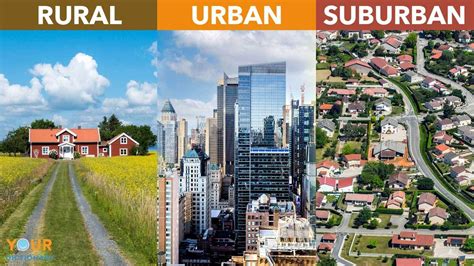Defining the Three Types of Communities
Understanding the distinctions between suburban, urban, and rural communities is crucial for urban planning, real estate decisions, and understanding social dynamics. Each type of community offers unique characteristics, advantages, and challenges.

Suburban
A suburban community is typically located on the outskirts of a major city. It offers a mix of urban and rural characteristics. Suburban areas are often characterized by:
- Single-family homes with yards: Most suburban homes are detached and have private outdoor space.
- Proximity to amenities: Suburban communities typically have access to essential services like schools, grocery stores, and healthcare facilities within a short driving distance.
- Lower population density: Suburban areas tend to have lower population densities compared to urban areas, but higher densities than rural areas.
Urban
An urban community is located within the central area of a city. It is characterized by high population density and a bustling atmosphere. Urban areas often feature:
- High-rise buildings: Many urban residents live in apartments or condominiums in multi-story buildings.
- Densely populated neighborhoods: Urban areas have high concentrations of people living in close proximity to each other.
- Extensive public transportation: Cities typically have robust public transportation systems, including buses, trains, and subways.
Rural
A rural community is located in a sparsely populated area, typically far from major cities. Rural areas are characterized by:
- Agricultural land: Rural communities often rely on agriculture as a primary economic activity.
- Low population density: Rural areas have significantly lower population densities than suburban and urban areas.
- Limited amenities: Rural communities may have limited access to certain amenities, such as healthcare facilities and entertainment venues.
Key Differences and Statistics
| Characteristic | Suburban | Urban | Rural |
|---|---|---|---|
| Population density (people per square mile) | 1,000-5,000 | 5,000-20,000 | <1,000 |
| Median household income | $70,000-$100,000 | $50,000-$80,000 | $40,000-$60,000 |
| Housing type | Single-family homes, townhomes | Apartments, condominiums, townhouses | Single-family homes, mobile homes |
| Access to amenities | Good access within a short driving distance | Excellent access within walking distance | Limited access, may require driving |
| Transportation | Primarily cars | Cars, public transportation, walking, biking | Primarily cars |
| Education | Good access to schools, colleges, and universities | Excellent access to schools, colleges, and universities | Limited access to colleges and universities |
| Healthcare | Good access to hospitals and clinics | Excellent access to hospitals and clinics | Limited access to hospitals and clinics |
| Employment | Mix of white-collar and blue-collar jobs | Primarily white-collar jobs | Primarily blue-collar jobs |
Factors Influencing Community Type
Several factors influence the development of different types of communities:
- Geography: The physical environment, such as topography and water availability, can influence settlement patterns and community growth.
- Economic activity: The primary economic activities in an area can shape the development of different types of communities.
- Social and cultural factors: The values, beliefs, and traditions of a community can influence its physical and social characteristics.
- Historical events: Historical events, such as wars or migrations, can play a role in the formation of different types of communities.
Advantages and Disadvantages
Suburban
-
Advantages:
- Privacy and larger homes
- Proximity to amenities and job opportunities
- Good access to education and healthcare
-
Disadvantages:
- Higher costs of living
- Limited public transportation
- Environmental impact of sprawl
Urban
-
Advantages:
- Vibrant atmosphere and cultural amenities
- Excellent access to public transportation and job opportunities
- Walkability and bikeability
-
Disadvantages:
- High cost of living
- Noise and pollution
- Limited outdoor space
Rural
-
Advantages:
- Tranquility and lower costs of living
- Close connection to nature
- Sense of community
-
Disadvantages:
- Limited access to amenities and job opportunities
- Challenges in healthcare and education
- Limited public transportation
Tips and Tricks for Choosing the Right Community Type
- Consider your lifestyle: Are you looking for a quiet life with privacy or a more vibrant, urban environment?
- Research different communities: Visit potential communities, talk to residents, and get a feel for the atmosphere.
- Evaluate amenities: Make sure the community has the amenities you need, such as schools, healthcare facilities, and entertainment venues.
- Consider the cost of living: Research the cost of housing, taxes, and other expenses in different communities.
- Think about long-term goals: If you’re planning to start a family or change your career, consider how the community can support your future needs.
FAQs
1. What is the difference between a small town and a rural area?
A small town is considered an urban area with a smaller population, typically less than 20,000 people. Rural areas typically have even smaller populations and are characterized by agricultural land use.
2. Can rural areas be sustainable?
Yes, rural areas can be sustainable by adopting innovative farming practices, fostering ecotourism, and promoting local businesses.
3. Why are urban areas so densely populated?
Urban areas are densely populated due to factors such as economic opportunities, cultural amenities, and limited land availability.
4. What is the future of suburban sprawl?
Suburban sprawl is an ongoing challenge, but there is a growing trend towards urban infill and development within existing suburbs.
5. How can we create more livable communities for all?
Creating more livable communities involves investing in affordable housing, improving transportation options, and promoting social equity.
6. What is the impact of technology on rural communities?
Technology can bridge the gap between rural and urban areas by providing access to education, healthcare, and economic opportunities.
7. How can we preserve the character of rural communities?
Preserving the character of rural communities involves supporting local businesses, protecting agricultural land, and promoting sustainable development.
8. What is the role of government in shaping community development?
Government plays a crucial role in shaping community development through policies that promote affordable housing, invest in infrastructure, and support local economies.
